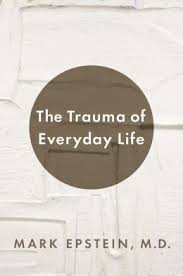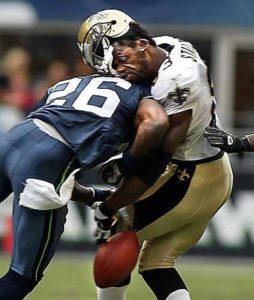I listened to a NPR segment this week about the connection between playing football in the NFL and brain trauma.
One retired running back said that each collision he suffered during a game “was like being in a car accident.” What a tremendous cost to pay, I thought.
For many of us, daily life is so demanding and stressful, that, like a football player, it’s like being in a series of car accidents. The word “stress” doesn’t even seem to do justice the corrosive experience of so much stress– “trauma” is more like it.
The trauma isn’t the type inflicted by bone jarring hits during a football game — it’s psychological, though no less real.

In his book, The Everyday Trauma of Life, psychiatrist Mark Epstein writes in a recent New York Times article,
“Trauma is not just the result of major disasters. It does not happen to only some people. An undercurrent of trauma runs through ordinary life, shot through as it is with the poignancy of impermanence. I like to say that if we are not suffering from post-traumatic stress disorder, we are suffering from pre-traumatic stress disorder. There is no way to be alive without being conscious of the potential for disaster. One way or another, death (and its cousins: old age, illness, accidents, separation and loss) hangs over all of us. Nobody is immune. Our world is unstable and unpredictable, and operates, to a great degree and despite incredible scientific advancement, outside our ability to control it.”
Such trauma not only impacts our psychological/emotional and spiritual selves, but our physical brains.

In a brilliant article in The Wall Street Journal this week entitled, “Stress Starts Up The Machinery of Major Depression”, Robert Sapolsky, Ph.D., points out that there are many factors that increase our risk of major depression including genes, childhood trauma, and endocrine and immunological abnormalities.
But a frequent trigger is stress.
Sapolsky writes, “The stress angle concerns ‘adhedonia,’ psychiatric jargon for ‘the inability to feel pleasure.’ Adhedonia is at the core of the classic definition of major depression as ‘malignant sadness’”.
As a person who has a genetic history of depression in his family and childhood trauma, I was drawn into Sapolsky’s article. What was the connection between stress and the malignant sadness I’ve experienced off and on since being diagnosed with depression twelve years ago?
Who would have thought that rat brain research would help me understand the link?
Sapolsky gives us a little background about our brain structure by letting us know that our abilities to anticipate, pursue and feel pleasure revolve around a neurotransmitter called dopamine in a region of the brain called the nucleus accumbens. Then he turns to the rats for further illumination:
“Put a novel object – say, a ball – in a mouse’s cage. When the mouse encounters the ball and explores it, the arousing mystery, puzzle and challenge cause the release of a molecule in the nucleus accumbens called CRF, which boost dopamine release. If an unexpected novel object was a cat, that mouse’s brain would work vey differently. But getting the optimal amount of challenge, what we’d call ‘stimulation,’ feels good.”
We humans need just enough challenge and stress to make life interesting.
“CRF mediates this reaction: Block the molecule’s actions with a drug, and you eliminate the dopamine surge and the exploration,” writes Sapolsky. “But exposing a mouse to major, sustained stress for a few days changes everything. CRF no longer enhances dopamine release, and the mouse avoids the novel object. Moreover, the CRF is now aversive: Spritz it into the nucleus accumbens, and the mouse now avoids the place in the cage where that happened. The researchers showed that this is due to the effects of stress hormones called glucocorticoids. A switch has been flipped; stimuli that would normally evoke motivated exploration and a sense of reward now evoke the opposite. Strikingly, those few days of stress caused that anhedonic state to last in those mice for at least three months.”
Sapolsky concludes:
“But meanwhile, these findings have an important implication. Life throws lousy things at us; at times, we all get depressed, with a small letter “d.” And most people—as the clichés say—get back in the saddle; prove that when the going gets tough, the tough get going. What then to make of people who are incapacitated by major depression in the clinical sense? Unfortunately, for many, an easy explanation is that the illness is a problem of insufficient gumption: ‘Come on, pull yourself together.’ There is a vague moral taint.”
The trauma of everyday stress is an important player in major depression. When combined with genetic history and a difficult childhood, it can tip the applecart and result in what Andrew Solomon calls “The Noonday Demon”. The takeaway is that the better we get at managing the “trauma of everyday life”, the better chance we have at preventing depression.
My worry is that the society we’ve created and the hectic lives we lead make the management of stress very difficult, indeed.












